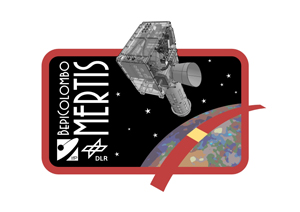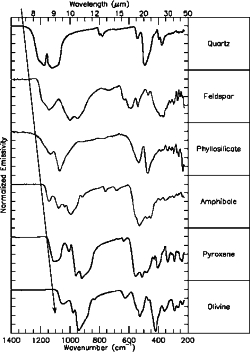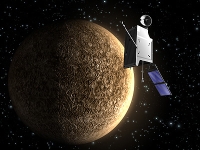Mercury Radiometer and Thermal Infrared Spectrometer (MERTIS)
Uncovering the secrets of Mercury ...

BepiColombo, Europe's first mission to Mercury, will set off in July 2016 on a journey to the smallest and least explored terrestrial planet in our Solar System. The mission contains two spacecraft: the Mercury Planetary Orbiter (MPO) and the Mercury Magnetospheric Orbiter (MMO). One instrument on the MPO of BepiColombo is MERTIS (Mercury Radiometer and Thermal Infrared Spectrometer), which is an innovative instrument for studying the surface composition and mineralogy of planet Mercury.
Since 2005 the Institute für Planetologie in Münster was involved in conceptual studies, design, and development of the instrument, which resulted in a successful pre-shipment review of the MERTIS flight model (FM) in summer 2013. The completed FM is now successfully integrated on the satellite and is ready for final tests on-board BepiColombo.
MERTIS flight model


Visible on the right is the planet baffle. The inside of the space baffle is seen in the center. Dimensions of the MERTIS housing are 180 × 180 × 130 mm; space baffle is about 200 mm long. Space baffle on top, planet baffle facing the viewer. We Start: Countdown
Countdown
Team
MERTIS is a joint effort of the Institut für Planetologie (IfP) in Münster, Germany, where the Principal Investigator, or PI, is located, two institutes at the Deutsches Zentrum für Luft- und Raumfahrt (DLR), and industrial partners.
Founded in 1986, the IfP is the only university institute dedicated to planetary research in Germany. Since 2005, the MERTIS project is located at the IfP. In 2007, Prof. Dr. Harald Hiesinger took over the role of PI from Prof. Dr. Elmar Jessberger, who led the project from the conceptual study through most of the definition phase and who continues to serve the project as Co-I. Hiesinger is a geologist whose research interests include the Moon, Mars, Vesta, and Mercury. In particular, he is interested in the geologic history and evolutions of planetary bodies, as well as geologic processes such as impact cratering, volcanism, and tectonism.
Supporting the PI is the project office, led by Dr. Iris Weber. She is a geoscientist and was already involved as a collaborator in the MIDAS experiment on Rosetta and is also involved in the RLS experiment on the ExoMars Mission. During her PhD thesis she was working on microstructural investigation of achondrites including Martian meteorites and eucrites. As a post-doctoral fellow she was working on interplanetary dust particles (IDPs), as well as on the MIDAS, and the Stardust experiments.
Dr. Andreas Morlok has a background in Fourier Transform Infrared Spectroscopy (FTIR) studies of a wide range of materials – minerals, terrestrial rocks, and meteorites. He has been working in England, Japan, and France before coming to Münster in 2012. He is studying the infrared properties of laboratory samples for the interpretation of future results of MERTIS.
The IfP has upgraded the infrared laboratory and installed a new up-to-date Bruker VERTEX 70v FTIR system. This device enables infrared analyses of samples under various settings, e.g., in vacuum and under different angles. The new instrument can be used to conduct further research in preparation for the MERTIS data evaluation. Together with Dr. Andreas Morlok, Manuel Tiedeken is responsible for operating the new spectral laboratory.
Dr. Aleksandra Stojic has a background in mineralogy. During her PhD she focused on characterizing presolar grains with the NanoSIMS and TEM. In collaboration with external partners she is producing space weathering analogues to investigate possible changes at nano- and microscales induced by space weathering effects on the resulting IR spectra.Another MERTIS team member is Karin Bauch. As a PhD student, she develops numerical models of Mercury's surface temperature distribution.
Prof. Dr. Addi Bischoff supports the MERTIS team with his expertise in mineralogy and meteoritical science.Our Partners
The IfP is closely cooperating with two DLR institutes located in Berlin (DLR – Institut für Planetenforschung/PF and DLR – Optische Informationssysteme/OS). Dr. Jörn Helbert from DLR-PF is serving as Co-PI and science manager. Gisbert Peter from DLR-OS is the project manager at DLR.
We have selected a number of industrial partners who are responsible for various contributions to MERTIS. Our partners are the Erwin Kayser-Threde GmbH, the Ingenieurbüro Ulmer — Technische Informatik, and the QUAPRO Ingenieurbüro. A number of sub-contractors are also contributing to MERTIS, including IOF (Institut für Angewandte Optik und Feinmechanik) and PAS (Polish Academy of Science).Team Members
Johannes Benkhoff ESTEC Harald Hiesinger Institut fuer Planetologie, WWU Muenster Andreas Morlok Institut fuer Planetologie, WWU Muenster Iris Weber Institut fuer Planetologie, WWU Muenster Karin Bauch Institut fuer Planetologie, WWU Muenster Aleksandra Stojic Institut fuer Planetologie, WWU Muenster Addi Bischoff Institut fuer Planetologie, WWU Muenster Jörn Helbert
Deutsches Zentrum fur Luft- und Raumfahrt (DLR) e.V. Mario D'Amore Deutsches Zentrum fur Luft- und Raumfahrt (DLR) e.V. Alessandro Maturilli Deutsches Zentrum fur Luft- und Raumfahrt (DLR) e.V. Joerg Knollenberg Deutsches Zentrum fur Luft- und Raumfahrt (DLR) e.V. Ekkehard Kuhrt Deutsches Zentrum fur Luft- und Raumfahrt (DLR) e.V. Indhu Varatharajan Stony Brook University Stephane Erard Observatoire de Paris Gabriele Arnold Deutsches Zentrum fur Luft- und Raumfahrt (DLR) e.V. Mark Robinson Arizona State University, School of Earth and Space Exploration Neil Bowles Atmospheric Physics Clarendon Laboratory Oxford University Benjamin T. Greenhagen Johns Hopkins Applied Physics Laboratory Urs Mall Max-Planck-Institut für Sonnensystemforschung Pierre Vernazza Laboratoire d´Astrophysique de Marseille Olivier Groussin Laboratoire d´Astrophysique de Marseille Christian Wöhler Image Analysis Group
Faculty of Electrical Engineering and Information Technology TU Dortmund UniversityLjuba Moroz Deutsches Zentrum fur Luft- und Raumfahrt (DLR) e.V. Gisbert Peter Deutsches Zentrum fur Luft- und Raumfahrt (DLR) e.V. Luigi Colangeli ESTEC Walter Ingo Deutsches Zentrum fur Luft- und Raumfahrt (DLR) e.V. Ann L. Sprague University of Arizona M. Rataj Space Research Centre of Polish Academy of Sciences; Simon Calcutt Atmospheric Physics Clarendon Laboratory Oxford University News
En route to Mercury
Scientists and contractors celebrate the kick-off for the next project phase of MERTIS. Named C2/D, it will culminate in the fabrication of a flight model following a sequence of various engineering models enabling development of the spectrometer …
http://www.uni-muenster.de/Rektorat/upm2/2009/upm11237.htmThe secrets of the “Messenger of the Gods”
German spaceflight agency grants an additional 11.4 million Euros for Münster’s contribution to the BepiColombo mission to planet Mercury …
http://www.uni-muenster.de/Rektorat/upm2/2009/upm11135.htmFurther 900,000 euros for flight to Mercury
The German Ministry of Research has approved a further 900,000 euros for
Münster planetologists to take part in the European "BepiColombo" space mission.
Further 900,000 euros for flight to MercuryInstrument
A Mercury Thermal Infrared Spectrometer
Selected by ESA to be one of eleven instruments aboard the MPO spacecraft, MERTIS will map the surface mineralogy of Mercury with a spatial resolution of at least 500 meters. It is an imaging spectrometer covering the thermal infrared, or IR, range.
Colorful rocks
Photons hitting a surface — like rays of light from the sun hitting the surface minerals on Mercury — can either be reflected, scattered, transmitted or absorbed. Of course, surface materials can also emit photons. To meet the goals of its mission, MERTIS will measure the spectral emittance of Mercury's surface. Different types of surface materials generate various kinds of spectra, thus exploring the innermost planet of the solar system starts in laboratories right here on Earth, where scientists analyze spectra of candidate materials that they expect to find on Mercury. Later, this will enable them to interpret the MERTIS data beamed back to Earth.
IR spectroscopy reveals rocks appearing gray or brownish to the human eye to be actually quite colorful indeed. This can be accomplished by translating the intensity of reflected IR light in or around peculiar features to visible wavelengths. The figure below shows how location and emissivity at characteristic features — emissivity maximum and transparency minimum in this case — vary for selected minerals. The features that we are interested in are located at wavelengths between 7 and 14 µm. MERTIS will operate in this range.

Studying Mercury's surface composition and identifying rock-forming minerals will allow scientists to assess theories about the planet's creation and thermal history. But MERTIS will also be used to conduct radiometric measurements to accomplish the final requirement of its mission, which is to examine thermo-physical properties of Mercury's surface.Why sending a spectrometer to Mercury?
The Mariner 10 spacecraft — hindered by technical failures — briefly encountered Mercury three times. Half the planet's surface was imaged. Most of what we know about Mercury comes from the flight of Mariner 10.
Spectral observations of Mercury can indeed be carried out from Earth using ground-based instruments. But spectra obtained to date are of low resolution. They even may be integrated over the complete visible surface of the planet. Furthermore, observing Mercury from down here is a most complex task due to its close proximity to the sun. The planet never rises high in the night sky and during daytime, the sun easily outshines it.
Putting a spectrometer into an orbit around Mercury seems to offer the optimal solution, but gives rise to problems of a different kind ...

Challenging demands
MERTIS will operate in an extreme thermal environment. The challenge is to design an instrument that delivers the requested scientific performance at demanding thermal conditions at low mass and power. Of course, resources provided by the carrier spacecraft must be shared with other experiments and instruments aboard.
The sensor head
Heart of the MERTIS instrument is its sensor head. This is where the detector for 7 – 14 µm infrared radiation is fitted. Its spectral resolution will be below 200 nm. To meet thermal requirements, a detector array based on micro-bolometer technology will fly on MERTIS that does not need to be cooled. A micro-bolometer can detect the energy density of radiation by measuring heating due to absorption — it's a kind of thermometer!
The sensor head also includes a three-mirror anastigmat through which light must travel. This device forms approximate point images.
The MERTIS sensor array will not continuously look at the surface of Mercury. To enable in-flight calibration, it constantly switches its field of view from the surface to open space and to black body radiators — one at 300 K and one at 700 K.New destinations
A modified version of MERTIS called SERTIS may fly to the moon early next decade aboard the German LEO spacecraft. Goals of the SERTIS instrument are analog to those of MERTIS. But in addition to exploring the lunar surface, SERTIS will also allow for a direct comparison of both our moon and Mercury with respect to surface mineralogy.
MERTIS and SERTIS will answer questions about the formation of the solar system and planetary accretion — and undoubtedly will pose many new ones that future generations of planetary scientists will have to attend to ...Mercury — the innermost planet
Mercury — the innermost planet
Of the eight planets in the solar system, Mercury clearly holds a special place due to its close proximity to the sun and its astonishing physical properties.

Mercury in the solar system
While the distance of our home planet to the sun amounts to about 150 million kilometers, Mercury's is 58 million kilometers in its closest approach. It takes us 365 Earth days to complete one orbit around our central luminary — Mercury does it in less than 90. And one day on Mercury is as long as six months on Earth.
But differences between Mercury and Earth — or the other two terrestrial planets in the solar system — go far beyond orbital mechanics ...

A heart of molten iron?
At first sight, Mercury closely resembles the Earth's moon, as it is as heavily cratered. But this observation merely holds true at the surface. Within, Mercury reveals an at least partially molten core that likely consists of mainly iron and that encompasses half the planet's volume. Mercury's density is twenty percent greater that that of the Earth — although it is only fourty percent larger in size than our moon.
An inner core acting as a dynamo would explain why Mercury was determined by the Mariner 10 spacecraft to have a weak magnetic field. A light constituent such as sulfur would greatly enhance chances for a partially molten core. The presence of sulfur would also imply that Mercury originally accreted at a different location in the solar system as volatile elements could not have condensed so close to the sun.

But why is Mercury so dense? Possible explanations include an asteroid hitting the early, possibly Earth-like Mercury and ripping off large parts of its rocky mantle. This would explain the enormous size of the proposed iron core relative to the planetary radius. It should be noted though that iron is yet to be found on the Mercurian surface. There is no direct evidence to date for its presence.
A G2V star in the neighbourhood
When standing on the surface of Mercury and looking up to the sun, its disk would appear more than twice as large to us than as seen from Earth. The sun's radiant heat and the lack of a mentionable atmosphere is the reason for sharp temperature contrasts on Mercury. Its sun-facing hemisphere reaches temperatures as high as 440°C, but ground temperatures in craters close to the poles can be as low as -170°C and it is believed that in their shadows they may conceal frozen water — ice!
Like the moon, Mercury's gravity is to low to retain an atmosphere. But surrounding it can be found what is called an exosphere — a flimsy gas cloud surrounding the planet which consists of particles from the solar wind trapped in the hermian magnetic field and also from the surface of Mercury itself produced by radioactive deacy.Earthly visitor
Why is Mercury so dense? How did it come into being? Why does it posses a magnetic field? What exactly is hiding at the planet's poles? To answer such questions we have about Mercury, ESA together with JAXA has created the BepiColombo mission consisting of two spacecraft — the Mercury Planetary Orbiter, or MPO, and the Mercury Magnetospheric Orbiter also known as MMO. Launch is projected for 2014. The journey will take six years to complete. While the Japanese MMO is to gauge Mercury's magentic field, the European MPO will explore its surface.
A high-performance suite of instruments has been gathered for the MPO and is currently under development all across Europe. One of them is the Mercury Thermal Infrared Specrometer — MERTIS!
JPL's Planetary Photojournal
An Atlas of Mercury from NASA
The BepiColombo mission

